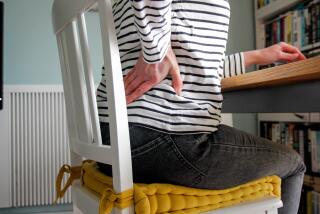Not everyone hurts the same way
- Share via
Pain is private. Unlike blood pressure or temperature or other symptoms easily measured and defined, the physical reaction to unpleasant stimuli is hard to quantify or predict. It varies from person to person, with each individual describing pain — and its intensity — differently.
But that private perception can make the difference between a trip to the medicine cabinet for an aspirin or a trip to the doctor’s office for something much stronger.
FOR THE RECORD:
Pain perception: An article in Monday’s Health section about how people feel pain differently included a quotation that read, “If you took a portable radio that needs a AAA battery and you put in a large D battery, you could burn the circuit out or cause static.” While in some instances changing the power supply in a circuit could damage the circuit, a device powered by a AAA battery would simply run for a longer time when powered by a D battery. —
Researchers study pain not to separate whiners from stoics but to understand why pain varies and, eventually, create individually tailored treatments for the many specific ailments that fall under the umbrella of pain.
If you place your hand on a metal plate that slowly heats up, you’ll reach your pain threshold when the heat first feels painful. Keep your hand on the heating plate until you can’t take the pain any more and you’ve found your pain tolerance. Threshold and tolerance are studied separately, and researchers have found consistent differences in how people report both.
The reasons for such differences are both psychological and biological — personal expectations, societal norms, genetics, hormones and even how much sleep you get. All have implications for pain treatment.
Genetics
Genes determine much of how we perceive pain because all of the bits and pieces of the nervous system are built from instructions in the genetic code, which varies slightly from person to person.
But a boy in Pakistan who can pass knives through his arm without feeling pain and a woman in China who experiences the intense, burning pain of erythromelalgia have one thing in common — mutations in the same gene. This gene, SCN9A, which has been the focus of a flurry of recent pain research, holds the code for a type of molecule, called a sodium channel, on the surface of nerve cells. Touch something painful, such as a hot plate, and a sodium channel opens a gate that allows signals to run to your brain, which interprets these signals as pain.
In the body, sodium channels are the gatekeepers for many signals in many different kinds of tissues. Dr. Stephen Waxman, a neurology professor at Yale University and the Department of Veterans Affairs, likens the sodium channels of the nervous system to batteries: “If you took a portable radio that needs a AAA battery and you put in a large D battery, you could burn the circuit out or cause static.”
Because such extreme differences in pain perception boiled down to the same gene, researchers decided to look at whether it affects pain perception in people without pain disorders. In a study published in January, they found that people who had a normal variation in the gene also had higher pain thresholds. For those with the variation in both of their copies of the gene, thresholds were even higher.
This gene has been particularly well-researched, but other studies are focusing on additional genes. “I think that there is going to be a number of other pain genes, but it may not be more than a handful that influence pain threshold, and I bet they’ll all come out in the next two years,” says Dr. C. Geoffrey Woods, a geneticist at the University of Cambridge and one author of the recent study.
Age
Pain can be very different in infancy than in old age. Until the last two decades of the 20th century, it was thought that babies didn’t feel pain. Infants were not given anesthesia during surgery because doctors considered it unnecessary for pain control and because they feared a potentially lethal anesthesia overdose. Medical opinion has since reversed.
“Not only do they experience pain, but the more pain they experience, that influences their perception of pain as they get older,” says Allan Basbaum, professor and chairman of anatomy at UC San Francisco and editor in chief of the journal Pain. More pain early on means a higher sensitivity to pain later.
Studies of pain sensitivity in elderly patients show that they have a higher threshold for brief exposure to superficial pain, such as heat, in part because peripheral nerves become less sensitive as we age. However, the elderly are more sensitive to deep muscular pain, and some studies suggest that their biological pain control systems don’t work as quickly as in younger patients, says Roger Fillingim, a psychologist and professor of community dentistry and behavioral science in the University of Florida College of Dentistry.
Mood
Like old age, depression can increase a person’s threshold for brief pain, says pain researcher Fillingim, although some studies have shown conflicting results. There is widespread agreement, however, that depression lowers pain tolerance.
And that doesn’t just go for the truly depressed: making people temporarily unhappy by showing them sad photographs also increases pain sensitivity.
The mood-and-pain-perception link is bad news for those who dread the dentist’s drill. People who are anxious about pain become more pain-sensitive in the situations that evoke their pain-related anxiety, Fillingim says. General anxiety, however, does not have much effect on pain sensitivity.
Researchers speculate that chemicals in the brain, such as serotonin, may be involved in both mood and pain perception. The exact link between pain and depression is unclear, but “managing depression always increases pain control,” Woods says.
Sleep
It may come as no surprise that pain can keep you up at night, but the relationship appears to be two-way: Those missed Zs can increase pain sensitivity.
Like mood, sleep is affected by brain chemistry.
Chronic pain conditions such as fibromyalgia and irritable bowel syndrome are often tied to sleep disturbances.
In a June 2009 study of patients with temporomandibular joint disorder, researchers from Johns Hopkins University and other institutions found that patients who also had a certain type of insomnia had significantly lower pain thresholds. In a 2008 study, the same team found that burn patients who had insomnia reported more severe, longer-lasting pain than those who fell asleep promptly.
Gender and hormones
Scientists have known for a few decades that men and women feel pain differently. “With standard pain stimuli in the lab, women have both a lower pain threshold and a lower pain tolerance,” Fillingim says. “However, there is controversy about what these findings mean in real life or with actual clinical pain.”
Some reported differences are due to gender roles — men being macho and women being more willing to admit to pain, Fillingim says, “but even if you control for gender role, the sex difference is still there.”
There may be both biological and psychological reasons behind these differences. Research shows sex hormones seem to play a role in pain perception, with multiple studies indicating that pain thresholds rise when women are in the later part of the menstrual cycle, when estrogen levels are higher.
Psychologically, different pain coping mechanisms may be used by men and women, contributing to the measured differences in pain perception.
Ethnicity
Differences in pain sensitivity have also been measured among ethnic groups.
In the U.S., minority groups report more pain from certain conditions, such as osteoarthritis, than do the majority non-Latino whites. However, minority groups are also less likely to receive treatment for pain in the first place, which may mean they are more likely to develop chronic pain.
Research on pain threshold and tolerances is more limited for ethnicity than for gender, but some studies report lower pain tolerance in African Americans than in whites, although pain thresholds are similar.
The differences may be more cultural than biological. Fillingim points to differences in trust: In a typical pain study, participants touch a surface that heats up until the maximum pain tolerance is reached and the participant pushes a button to stop the experiment. “Now, if I’m somebody who doesn’t trust the experimenter, I might go ahead and press it early just to make sure they turn it off, and there is evidence in the literature in general that African Americans mistrust medical researchers more than whites do,” Fillingim says.
Psychological factors
Researchers are just beginning to reveal the full extent to which the biology and psychology of pain are interwoven, but it’s clear that expectations and attention are major players.
When it comes to pain, what you expect is what you get. On the whole, when people expect to have more pain, they have more pain, and when they expect to have less, they actually have less, Fillingim says.
Expectations can work in patients’ favor when it comes to pain management: the well-known placebo effect means that when someone expects that a treatment will work, it tends to work better than if the person expects that it will not work. This goes for sham treatments and genuine treatments.
One potential way to circumvent expectations is a healthy dose of distraction. Researchers at the University of Washington report that immersive virtual reality games significantly lower the pain reported by burn patients during wound care.






